




An Overview of Class 9 Biology Characteristics Of Members Of Plant Kingdom Experiment
Biology Experiment - Study The Characteristics Of Members Of Plant Kingdom
We can see plants all around us; they are the reason for the sustenance of life on earth as they are the only producers in our ecosystem. Classification of plants is done into five major divisions, i.e., thallophytes, bryophytes, pteridophytes, gymnosperms and angiosperms. Plants are classified into these divisions based on their cell type, body structure, ability to bear flowers and whether their seeds are naked or covered. In this experiment, we will collect the plant specimens and observe the specimens under a microscope. Observation will be made based on the anatomical and morphological characters of the Plant specimen.
Table of Contents
Aim
Apparatus required
Theory
Procedure
Observations
Result
Precaution
Aim
To study the characteristics of Bryophytes, Saprophytic plants, and Pinus. Also draw and give identifying features of the group.
Materials Required
Moss, fungi, Pinus Cone (male or female), Compound microscope, slides and coverslips.
Theory
Classification of Plants
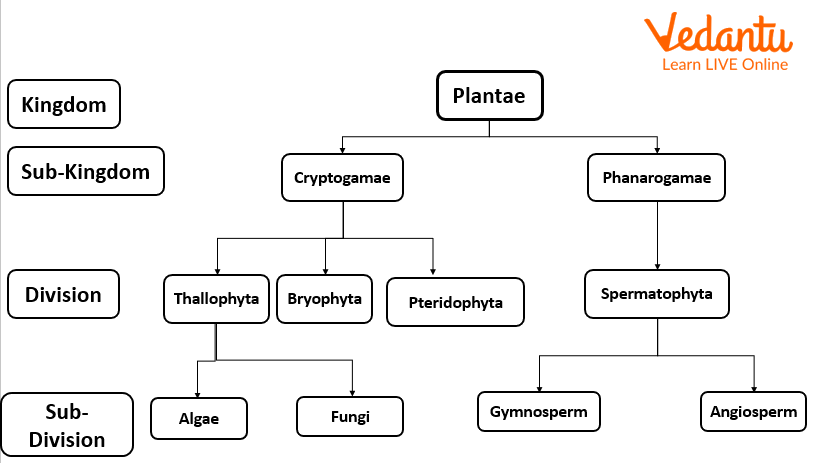
Classification of Plants
Kingdom Plantae
Autotrophic
Non-motile
Reproduce sexually, asexually and vegetatively
Subkingdom- Cryptogamae
Less advanced plants with root like,and leaf like structures.
Absence of flower and seed.
Division
Thallophyta
Absence of true roots.
Absence of vascular tissues.
Example- Algae and Fungi.
Bryophyta
Thallus is like a plant body.
Presence of rhizoids, which are unicellular or multicellular.
Amphibians of plant kingdom
Example- Moss, Liverworts and Hornworts.
Pteridophyta
Presence of vascular tissues.
Plant body possesses true roots, leaves and stem.
Example- Fern, Lycopodium.
Subkingdom- Phanerogamae
Presence of seed, flowers and well developed vascular systems are the characteristic features of phanerogams.
Division
Spermatophyta
Plants possess root, stem, leaves and seed bearing structure.
They have highly developed vascular tissue xylem with both xylem tissue and tracheids.
Sub-Division- Gymnosperm
Do not produce flowers.
Presence of naked seed.
They form cones with reproductive structures.
Example- Cycas, Pinus.
Sub-Division- Angiosperm
All plants bear flowers.
Seeds are enclosed inside fruits.
Presence of true vascular tissues, xylem and phloem.
Complex root system is present.
Example- Mango, Banana.
Procedure
Gather the plant specimen with the help of your teacher.
Put some moss on the clear glass slide, cover it with a cover slide and observe it. Note the characters and make a well-labeled diagram.
Put the fungi specimen on a clear glass slide and then cover it with a cover slip. Note the characters and make a well labeled diagram.
Observe the given specimen of Pinus and take a note of their characteristics. Draw a well labeled pinus cone diagram.
Observation
1. Moss
Identifying Characters
Absence of roots.
Presence of rhizoids.
Gametophyte contains small green leaves which are spirally arranged.
Seta (stem-like structure in the sporophyte) are very weak and generally greenish to brown.
Presence of unbranched stems.
Reproduces through spores.
Sporophyte is made up of foot, seta and capsule.
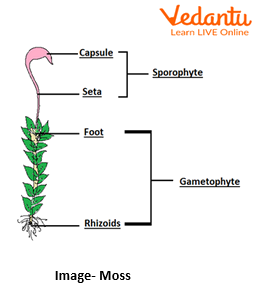
Moss
2. Fungus
Identifying Characters
Filamentous in structure.
They are formed of thread-like structures called hyphae. Network of hyphae forms a mesh-like structure called mycelium.
Cell wall is composed of chitin.
Absence of chloroplast. Therefore doesn’t perform photosynthesis.
Grow on dead and decaying matter. That means plants bearing saprophytic modes of nutrition.
Spore formation takes place for reproduction.
Absence of vascular tissues.
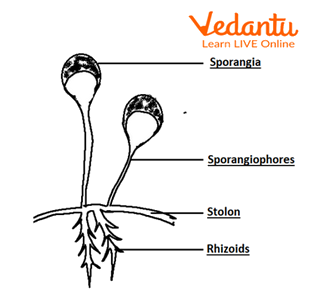
Fungus
3. Pinus
Identifying Characters
Plant body differentiated into stem, root and leaves,
Shows a well-developed tap root system.
Presence of seed, not enclosed in fruits.
Male Cone
Male cone is brown in color and oval in shape.
Male cones are found in clusters on long branches.
Contains microsporophyll arranged spirally around the axis.
Number of winged microspores present in microsporangia.
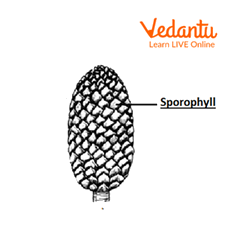
Male cone of Pinus.
Female Cone
Size of a female cone of Pinus varies with age. The cones are very small in the first year, but as they age, they become large and woody and are made of megasporophylls.
Female cones consist of a short axis around which the megasporophyll are spirally arranged, and each megasporophyll contains two ovules on the upper surface.
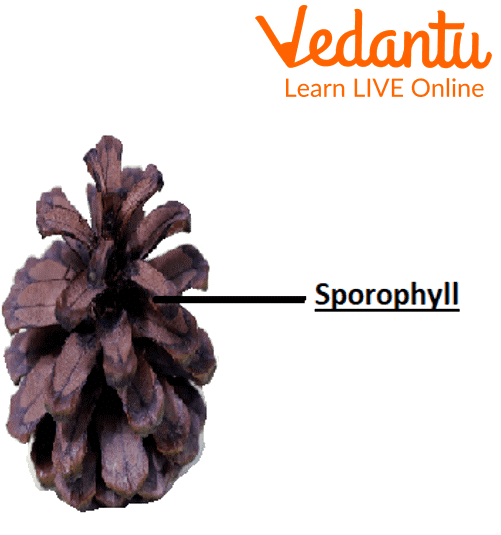
Female cone of Pinus.
Results
Precautions
Make sure that the glass slides are properly cleaned.
Make sure that the coverslips are not dirty.
Make sure to stain the specimen to observe a better structure of the specimen.
Make sure to set the microscope properly.
Lab Manual Questions
1. What do the cones of the Pinus plant represent?
Ans: Cones of Pinus represent the reproductive parts of the plant. The male cone is smaller in size and the female cones are larger in size.
2. Describe the common function of roots and rhizoids.
Ans: The common function of roots and rhizoids are as follows-
They help in attachment to the substratum.
They help in absorption of minerals and water.
3. Why are fungi not green in color?
Ans: The fungi are not green in color because of the absence of a pigment called chlorophyll in their cell.They follow saprophytic mode of nutrition as they feed on dead and decaying matter.
4. What is that mesh-like structure present in Fungi?
Ans: Fungus bodies consist of thread-like structures called hyphae. These hyphae form a mesh-like structure called mycelium.
Viva Questions
1. Name the amphibians of the plant kingdom.
Ans: Bryophytes are the amphibians of the plant kingdom.
2. What is the economic importance of cones?
Ans: The cone of Pinus can be used for timber and resin.
3. Which plants are known as flowering plants?
Ans: Angiosperms are flowering plants.
4. Who proposed the five kingdom classification?
Ans: R.H. Whittaker gave the 5 kingdom classification.
5. Name two thallophyta plants.
Ans: Spirogyra, Chara.
6. What type of mode of nutrition is seen in Fungus?
Ans: Saprophytic mode of nutrition because they feed on dead matter.
7.What are sporangiophores?
Ans: Sporangiophores are stalk-like structures which bear at their tips the sporangia which contains spores.
8. Name the sub-kingdom of the division Bryophyta.
Ans: Cryptogamae.
9.Give the common name of Agaricus.
Ans: Common name of Agaricus is Mushroom.
10.What is common in thallophytes?
Ans: They have thallus bodies. The body is not differentiated in root, stem and leaves.
Practical Based Questions
1. Some students want to prepare a temporary mount of Moss. Where should they search for a fresh specimen?
In a pond of a salty water
In a pond of stagnant dirty water
At a dry in background
At a shady and moist area
Ans: At a shady and moist area
2. Which of the following identifies a gymnosperm?
Naked seeds
Rhizoids present
Chlorophyll absent
Does not possess a vascular bundle.
Ans: Naked seed
3. Thallophytes include:-
Seed bearing plant
Algae
Ferns and their species
Mosses and liverworts.
Ans: Algae
4. Study of Fungus:-
Algology
Microbiology
Phycology
Mycology
Ans: Mycology
5. Underground stems in pteridophytes are known as:-
Rhizoids
Rhizome
Tube
Bract
Ans: Rhizome
6. Which of the following is a structure storing spores?
Sporophyll
Sporangia
Spermatophyte
Gametophyte
Ans: Sporangia
7. Which of the following possess mega and microsporophyll?
Neem
Moss
Agaricus
Pinus
Ans: Pinus
8. Mosses are
Monoecious
Dioecious
Both (a) and (b)
None of these
Ans: Monoecious
9. Which of the following have enclosed seeds?
Angiosperm
Gymnosperm
Pteridophyte
Bryophyte
Ans: Angiosperm
10. What is the needle shaped structure in the Pinus plant?
Leaf
Shoot
Stem
Reproductive part
Ans: Leaf
Summary
Plants are eukaryotic, multicellular and autotrophic. Classification of plants is based on the proper development of the body, the presence or absence of vascular tissues, open or enclosed seeds and flowering or non-flowering plants. Under kingdom plantae, there are two sub-kingdom, Cryptogams and Phanerogamae. Total 5 divisions are there, bryophyta, pteridophyta, thallophyta, gymnosperm and angiosperm.
FAQs on Class 9 Biology Characteristics Of Members Of Plant Kingdom Experiment
1. What are the five most important characteristics of Kingdom Plantae for a Class 9 exam?
For a 3 or 5-mark question in the CBSE 2025-26 exam, highlighting these key characteristics is crucial:
- Eukaryotic and Multicellular: Plant cells possess a well-defined nucleus and organelles. The organisms are composed of many specialised cells.
- Autotrophic Mode of Nutrition: Most plants contain the pigment chlorophyll and perform photosynthesis to synthesise their own food.
- Cell Wall Composition: Plant cells are protected by a rigid cell wall made primarily of cellulose.
- Sedentary Nature: Plants are generally non-motile and fixed in one place, typically anchored by roots.
- Life Cycle: They exhibit a life cycle that involves the alternation of generations between a diploid sporophyte and a haploid gametophyte.
2. Why are Bryophytes often called the 'amphibians of the plant kingdom'? This is a frequently asked 2-mark question.
Bryophytes are called the amphibians of the plant kingdom because they require both land and water to complete their life cycle. Although they live on land, specifically in moist and shady environments, they are dependent on water for sexual reproduction. The male gametes (antherozoids) need a film of water to swim to the female gamete (egg) for fertilisation to occur.
3. Differentiate between Gymnosperms and Angiosperms. What is the key feature to mention for full marks?
The key distinguishing feature, essential for scoring full marks, relates to how their seeds are borne. A clear comparison is as follows:
- Gymnosperms: The term translates to 'naked seeds'. In these plants, the ovules are not enclosed within an ovary wall. Consequently, the seeds that develop are exposed or 'naked'. Examples include pines and cycads.
- Angiosperms: The term translates to 'enclosed seeds'. In these flowering plants, the ovules are protected within an ovary. After fertilisation, the ovary develops into a fruit, and the seeds are found inside the fruit. Examples include mango, wheat, and pea plants.
4. A student finds a plant with a well-differentiated body and vascular tissues, but it does not produce seeds. Which division does it likely belong to and why?
The plant most likely belongs to the division Pteridophyta. The reasoning for this conclusion is based on two critical observations:
- The presence of a differentiated plant body (true roots, stem, and leaves) and specialised vascular tissues (xylem and phloem) for conduction separates it from the simpler Thallophytes and Bryophytes.
- The absence of seeds for reproduction distinguishes it from the more advanced Phanerogams (which include Gymnosperms and Angiosperms).
These features are the classic identifiers for Pteridophytes, such as ferns and horsetails.
5. What is the primary basis for the classification of Angiosperms into Monocots and Dicots? Provide one distinguishing feature expected in exams.
The primary basis for dividing the Angiosperms is the number of cotyledons, or 'seed leaves', present in the embryo within the seed.
- Monocotyledons (Monocots): These plants have seeds with only a single cotyledon. A common example is maize or rice.
- Dicotyledons (Dicots): These plants have seeds with two cotyledons. A common example is gram or bean.
A key distinguishing feature often asked in exams is the root system: monocots typically have a fibrous root system, whereas dicots have a prominent taproot system.
6. How does the complexity of the plant body serve as the first level of classification in the Plant Kingdom?
The first and most fundamental level of classification in the Plant Kingdom is based on whether the plant body is well-differentiated or not. This is a critical initial step because:
- Plants with a simple body that is not differentiated into true roots, stems, and leaves are grouped into the division Thallophyta. Their undifferentiated body is referred to as a thallus.
- All other plants that possess a more complex, differentiated body structure are then further classified based on subsequent criteria, such as the presence of vascular tissue. This initial separation effectively segregates the simplest plants from all others.
7. From an exam preparation standpoint for the 2025-26 session, why is it important to understand the evolutionary progression from Bryophytes to Angiosperms?
Understanding the evolutionary progression is a Higher Order Thinking Skill (HOTS) that helps in answering complex comparative and analytical questions, especially those for 5 marks. It shows a clear trend of adaptation to terrestrial life through the development of key features:
- Vascular Tissue: The absence in Bryophytes limits their size, while its development in Pteridophytes and beyond allowed plants to grow taller and live in drier conditions.
- Reproduction Method: A clear shift away from dependency on water for fertilisation is seen. While Bryophytes and Pteridophytes need water, the evolution of the pollen grain in Gymnosperms and Angiosperms eliminated this need.
- Seed Protection: The progression from the hidden, spore-based reproduction of Pteridophytes to the naked seeds of Gymnosperms, and finally to the protected seeds within a fruit in Angiosperms, shows increasing reproductive success and dispersal advantage.





































